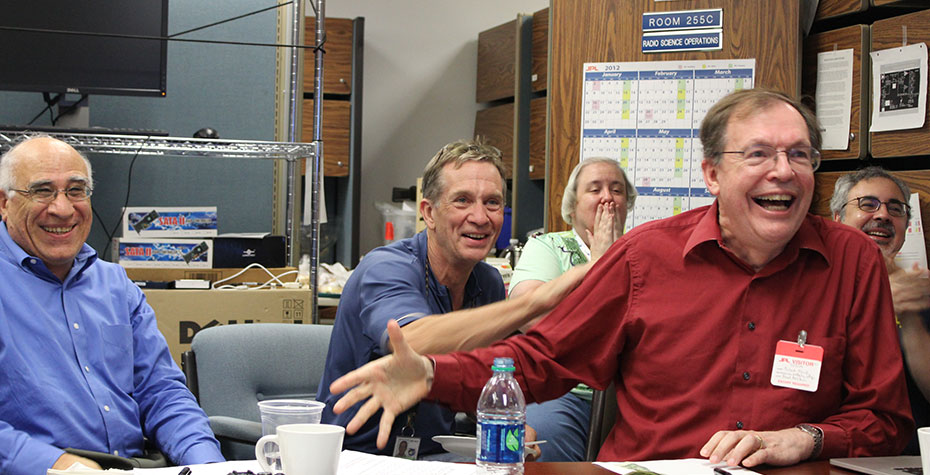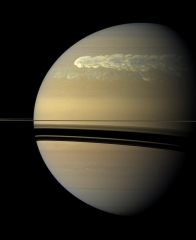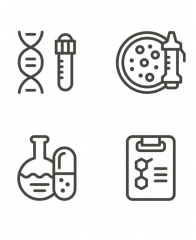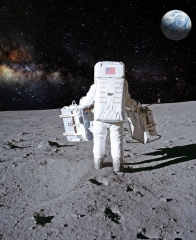 / Saturn—The Little Star That Couldn’t
Subscribe
/ Saturn—The Little Star That Couldn’t
Subscribe

On September 15, the spacecraft Cassini took its final dive into Saturn’s atmosphere to meet its “fiery death.” Wellesley College Professor Richard French, Louise Sherwood McDowell and Sarah Frances Whiting Professor of Astrophysics and Professor of Astronomy, was at the Jet Propulsion Lab (JPL) in Pasadena, shedding tears as the ship’s light dot in their monitors ceased to blink. The Spoke caught up with Professor French this week to talk about his long-time connection with Cassini and Saturn, science education, and the need for critical thinking in the uncertain times we live. We’ll publish this conversation in three parts, starting with the Cassini mission.
The Spoke: When and how did you join the Cassini mission? What planning was involved in it?
Richard French: I started quite some time ago, in 1989, when NASA set up what was called an announcement of opportunity to join the Cassini mission. As a much younger astronomer, I worked for a year on a proposal for an instrument for the spacecraft. In the final week before submitting that proposal, I was at Cornell with my collaborators and had a conversation with one of the members of my thesis committee:
"It's a great proposal Dick, but it will never get approved.”
“That's disappointing,” –I said, “why didn't you tell me that earlier?"
"You probably wouldn't have believed me.” –he replied.
“Well, I really wanted to be on the Cassini mission."
“You still can”, he said, “if you write a proposal to be a team member for a science instrument that's already on the spacecraft."
"But, proposals are due in a week."
“Then stop complaining and start writing."
In a sense, this is the term paper that I wrote the night before, and got an A. But I don't like to tell students this story [smiling]. I proposed to be a science team member for the radio science instrument to study Saturn's atmosphere and rings. My proposal was submitted in early 1990. We found out about six months later that I was on the team, and the spacecraft wasn't launched for another seven years. After the launch, it took another seven years to get to Saturn. We spent the first seven years designing the spacecraft, the instruments, the mission, and then we spent seven years planning the detailed dance of all of the orbits of the spacecraft around Saturn.
This planning is pretty different from a rover mission to Mars,where you can sit around a coffee table with the other scientists, and say, "that rock looks interesting, let's drive there tomorrow." For Cassini, we had to plan much more in advance, because what you can see is dictated by the orbit of the spacecraft. With a rover on Mars, you can it turn right or left, but you can't change the orbit of the spacecraft instantaneously and so we had an awful lot of planning to do.
The Spoke: In the past years you have been the Radio Science Team Leader of the mission. What is Radio Science and what questions can it help us answer?
RF: The radio science is one of twelve instruments on the spacecraft. Unfortunately, the only instrument that most people know about is the camera. We are a visual species and we love to look at pictures of Saturn's rings, atmosphere, and moons, but the visual part of the spectrum is a very narrow part of the electromagnetic spectrum. So we use other wavelengths to add to our knowledge. In this case, we use the radio signal, not just for communication to Earth but as a scientific probe. We arranged to have the radio instrument at a particular place (through those seven years of competition with all of the other scientists), so that the spacecraft can send a radio signal to Earth, for example, through Saturn's rings as it passes behind them. As that radio signal is blocked by the rings, scattered by the rings, interacting with the rings, we can get a very, very detailed map—of what the structure of the rings is. In fact, it is much more detailed than what you get in an image, by looking at a one-dimensional slice across the rings, but it isn't as photogenic so we never get the press [smiles]. However, in terms of understanding the details of what's going on in the rings, which is one of my main research focuses, it's really a supreme instrument.
It’s also versatile—we've provided one of the strongest tests of Einstein's theory of gravitation on the way out to Saturn when the spacecraft was on the far side of the Sun from the Earth. We measured the deflection of the radio signal by the Sun's mass and set (what is still) the world record for the best test of Einstein's theory of general relativity. We discovered undersea oceans on the moons Titan and Enceladus. We've bounced radio waves off of lakes of methane in the northern seas of Titan. And we experienced that live!

Because the radio science instrument is the only one on the spacecraft where you can actually see the data as they are coming back, we see a little flicker on the screen, and we could predict it within a few seconds, when we'd expected this radio signal, which is only 20 watts—it's a billion miles away, it has the strength of your refrigerator light bulb. And we're sending that radio wave, bouncing off of the surface of a small sea in the northern stretches of the moon Titan, pointing at it at just the right angle so that the reflection—if it gets reflected—will reach the earth. And it did! And by looking at detail at the nature of that reflection we could determine that those lakes were made of methane. And we could also figure out how strong the winds were on that day on Titan.
The Spoke: Any more exciting discoveries from the Cassini mission that you’d like to share with us?
RF: One of the fun things about Saturn is that it's such an amazingly diverse system. It has many moons, satellites, rings, storms; it's a giant planet which is mostly hydrogen and helium, kind of like Jupiter. It doesn't have a solid surface. I call it the little star that couldn't. It doesn't quite have enough mass for the hydrogen inside to get hot enough to turn into helium, which is why sun shines.
So it's a giant planet that resembles, in many ways, the hundreds and hundreds of other planets that we've seen around other stars that we've recently discovered. This was our opportunity to look in our own neck of the woods and in our own solar system at a representative of a giant planet and see what it's like. With the Cassini mission, we've learned about Saturn’s giant storms, but I think the moons and the rings really take the prize for the great discoveries.
We've explored Titan, a moon that has an atmosphere denser than the atmosphere we're breathing now. It has rain, it has rivers, it has lakes, it has seas, but the rain isn't water: it's methane. It is its own world that has seasons, sand dunes, changes over time; it's remarkable! The lakes and seas are about the size of our great lakes. We studied those lakes with a radar instrument on the spacecraft, and we constantly dive-bombed Titan, not only because it's an interesting target during the mission, but because we could use its gravitational energy as a slingshot to change the orbit of our spacecraft without having to use rocket fuel. So we constantly returned, like an annoying mosquito, to fly by Titan, and from that we were able to get many, many observations of its structure. Titan is extraordinary!
And then there's the moon Enceladus, which is about the size of Great Britain, a very small icy moon, which we had known about for a long time. It’s very bright -- one of the whitest objects in the solar system. We knew from Voyager observations—the spacecraft that went to the outer solar system before Cassini—that one side of this moon was heavily cratered and one side wasn't. That's hard to understand because craters come from impacts and why does one side lack impacts? The simplest explanation is that geological activity has eroded those, but it's so small that it's hard to think what the engine is—the source of energy that could produce that erosion.
And Cassini discovered that source of energy. It is shooting geysers of ice crystals, 60 km above the surface of Enceladus. Some of them have what we call escape velocity; it's so fast it escapes the gravitational pull of Enceladus but it can't escape the gravitational pull of Saturn, so it forms a ring around Saturn called, appropriately enough, the E-ring before we knew it came from Enceladus, which we know starts with E too. So it's a ring maker.
But the other interesting thing is that we have been able to fly through those plumes of salty ice, because we have arranged the spacecraft to dive bomb that moon, so we know exactly what the composition of those plumes is. It's salt water. Astronomers become biologists as soon you mention water, because they think it's just a simple step between that and life. But it's really true that in order to have liquid water that far out in the solar system, there has to be a source of heat underneath. And it's very plausible that the things on earth that we call hydrothermal vents, which may be a place where life emerged and evolved on the earth, have counterparts in the outer solar system. So it's opening our eyes to a new kind of environment in which to look for precursors to life or life itself.
Join us next time for the second part of the conversation with Prof. French.
Photo Credit (banner): Brian van der Brug, "Cassini team members," via Getty Images, 15 September 2017.
Photo Credit (in text): Aseel Anabtawi, "Successful arrival," via Jet Propulsion Labs, 2012.




